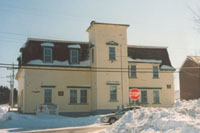
|
|
St. George's Courthouse (St. George's) There are only a few references in existing government records of any court facility at St. George's prior to the present edifice. One reference can be found in the 1889 report of John T. Nevill, Inspector of Public Buildings, concerning repairs being made to the court house at Bay St. George. In the same report, he also mentioned a court house at Sandy Point, now called Black Bank, just across the "gut" from present St. George's, which he considered "very old and dilapidated".
The Sandy Point building was partially reconstructed in 1889, and Mr. Nevill made a final reference to it in his 1891 Report. As the areas mentioned are so close, it is possible that the "two structures" were one and the same building. If this is so, it could have been erected as early as 1850 when the Newfoundland Government extended its influence to the French Shore. The structure may have even been rented and maintained by the Government. During July 1903, the plans were completed by the Department of Public Works for the "Proposed Court House, - St. George's, Bay St. George." Probably designed under Superintendent William Henry Churchill, the structure was constructed in the Second Empire Style, and was similar in nature to those already erected at Bonavista, Bell Island, Greenspond, Placentia, and Trinity. The closest counterpart for the St. George's Court House was the facility at Greenspond, which was designated as a Registered Heritage Structure by the Heritage Foundation of Newfoundland and Labrador in 1988. Both had two storeys whereas the other structures built to this standard plan had three. As well, the two buildings are similar in proportion, though the St. George's building was larger than the one in Greenspond. Each of these buildings is obviously intended for a smaller centre. Their large court rooms compensated for the lack of a third storey to maintain the majesty of the law. Both the Greenspond structure and the St. George's Court House were constructed of wood upon a concrete foundation. Dormer windows adorned the roof of each building, while a chimney graced each end of the structures. A door on the right side of the tower provided entrance to the building. The first floor contained the Post Office, Customs Office, three bedrooms, a parlour, four cells and a day room. The court room occupied the entire second floor, an unusual allocation of space for a structure of this size. A coved ceiling appears to have been the main feature of the court room which was lit by the numerous dormer windows.During 1943, the interior arrangements of the building were drastically altered. The ground floor was changed to accommodate the Constabulary (later the RCMP), a drug room, a treatment room and offices. Upstairs, the court room was reduced in size, while the remainder of the space was re-allocated to a hallway, the customs office, the district agriculturalist's office, the magistrate's office, a stenographer and the police. A new floor was also laid in various portions. Nine years later, further changes were made. A clinic replaced the gaol on the ground floor, and the gaol probably moved in to new quarters in the basement. In 1977, the structure housed the Welfare Department, the RCMP, the Magistrate's Court, and offices as well as the jail in the basement. The building is currently used as a band council office for the St. George's Indian Band, who plan on developing and restoring the building for use as an interpretation centre. The centre would include a Mi'kmaq library, court room, museum and craft shop. The St. George's Court House was designated as a Registered Heritage Structure by the Heritage Foundation of Newfoundland and Labrador on September 15th, 2001. |
